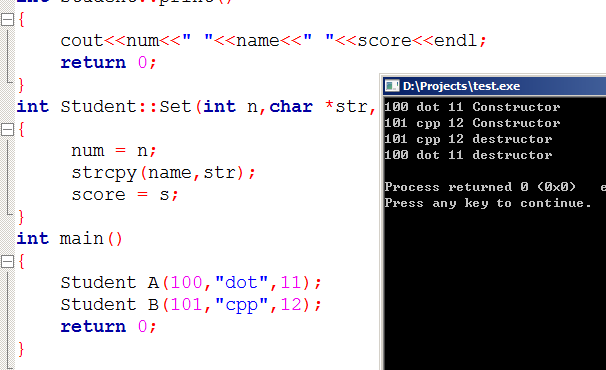除了上一节讲到的类对象在创建时自动调用的构造函数,在对象销毁时也会自动调用一个函数,它也和类名同名,也没有返回值,名字前有一个波浪线~,用来区分构造函数,它的作用主要是用做对象释放后的清理善后工作。它就是析构函数。
与构造函数相同的是,与类名相同,没有返回值,如果用户不定义,系统也会自动生成一个空的析构函数。而一旦用户定义,则对象在销毁时自动调用。
与构造函数不同的是,虽然他俩都为公开类型。构造可以重载,有多个兄弟,而析构却不能重载,但它可以是虚函数,一个类只能有一个析构函数。
下面,我们以Student类为例,继续添加析构函数,同时在构造函数和析构函数中都添加了输出当前类的信息,用来辨别哪一个类的创建和销毁,请大家仔细阅读代码:
#include<iostream>
#include<Cstring>
using namespace std;
class Student
{
private:
int num;//学号
char name[100];//名字
int score;//成绩
public:
Student(int n,char *str,int s);
~Student();
int print();
int Set(int n,char *str,int s);
};
Student::Student(int n,char *str,int s)
{
num = n;
strcpy(name,str);
score = s;
cout<<num<<" "<<name<<" "<<score<<" ";
cout<<"Constructor"<<endl;
}
Student::~Student()
{
cout<<num<<" "<<name<<" "<<score<<" ";
cout<<"destructor"<<endl;
}
int Student::print()
{
cout<<num<<" "<<name<<" "<<score<<endl;
return 0;
}
int Student::Set(int n,char *str,int s)
{
num = n;
strcpy(name,str);
score = s;
}
int main()
{
Student A(100,"dot",11);
Student B(101,"cpp",12);
return 0;
}请大家仔细理解上述代码中的构造函数和析构函数,并注意主函数中定义了两个对象A和B,并亲自上机测试,可以看到运行效果如下:

可以看到对象A和B的构造函数的调用顺序以及析构函数的调用顺序,完全相反!原因在于A和B对象同属局部对象,也在栈区存储,也遵循“先进后出”的顺序!
请大家务必亲自上机测试验证结果!
C语言网提供由在职研发工程师或ACM蓝桥杯竞赛优秀选手录制的视频教程,并配有习题和答疑,点击了解:
一点编程也不会写的:零基础C语言学练课程
解决困扰你多年的C语言疑难杂症特性的C语言进阶课程
从零到写出一个爬虫的Python编程课程
只会语法写不出代码?手把手带你写100个编程真题的编程百练课程
信息学奥赛或C++选手的 必学C++课程
蓝桥杯ACM、信息学奥赛的必学课程:算法竞赛课入门课程
手把手讲解近五年真题的蓝桥杯辅导课程